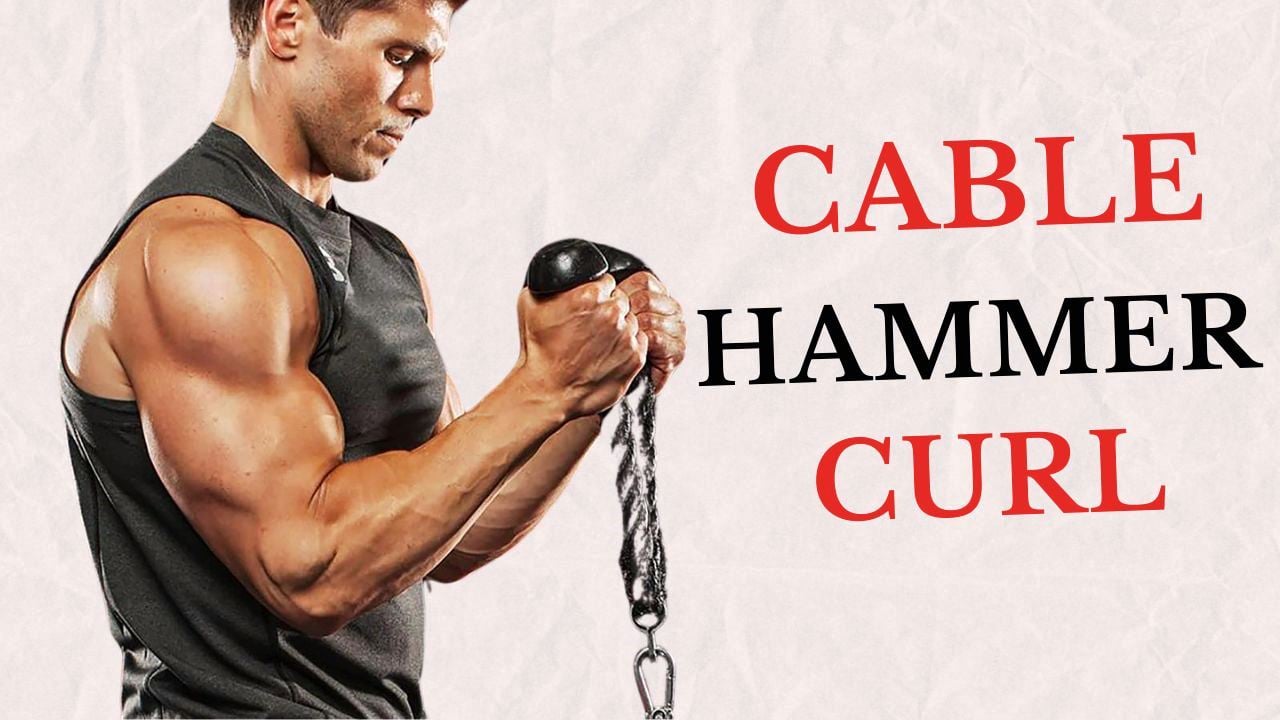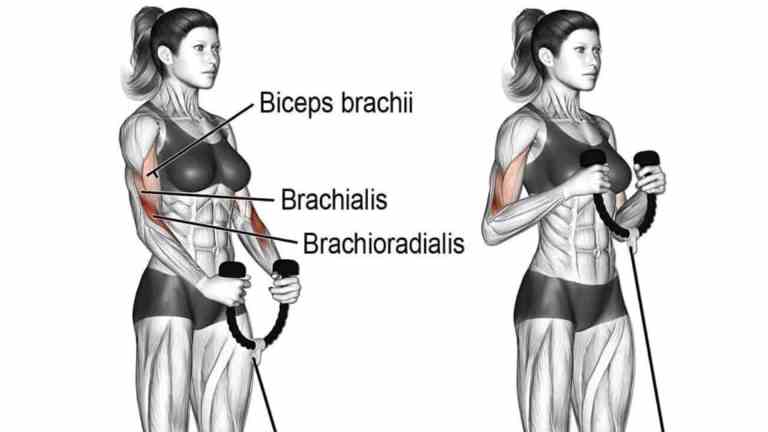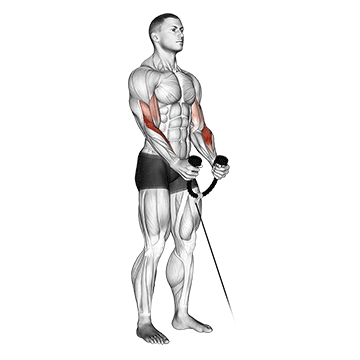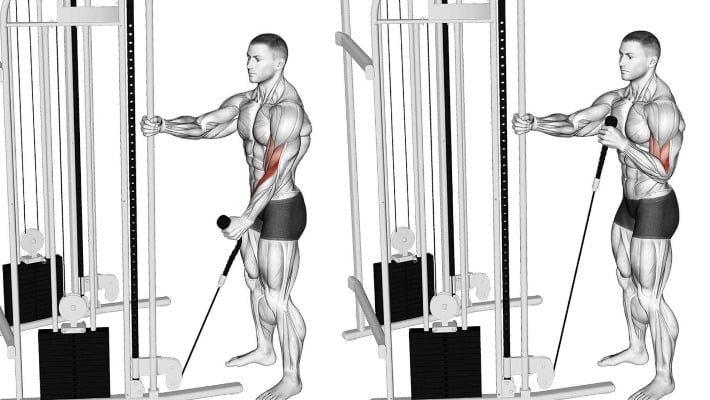The cable hammer curl is one of the best exercises that you can do to build your arm muscles.
When it comes to building massive biceps and forearms, the rope hammer curl is an effective isolation workout that also targets the brachialis and brachioradialis.
The cable rope hammer curls are very similar to the biceps curl, the only difference being the neutral /hammer grip (palms facing each other). It’s a variation of the hammer curl exercise.
As with a cable machine, it provides constant tension, which increases muscle activation and strength development.
Want to take your gains to the next level? Discover your daily calorie needs with our free TDEE calculator

- Cable Hammer Curl Muscles Worked
- How to Do Cable Rope Hammer Curl
- Workout Tips and Form
- Best Variations of Rope Hammer Curl
- 1. Single Arm Cable Hammer Curls
- 2. Cable Rope Hammer Preacher Curl
- 3. One Arm Cable Rope Hammer Preacher Curl
- Hammer Curls With Cable and Dumbbell
- FAQs
- Cable hammer curls vs. dumbbell hammer curl
- Are rope cable hammer curls good?
- Takeaway
- References
Cable Hammer Curl Muscles Worked
The cable hammer curl targets the upper and lower arm muscles — most notably the brachialis and brachioradialis.
The hammer curl has the involvement of several synergist muscles, these muscles include,
A handful of other muscles worked or play the role of stabilizer muscles, including your

How to Do Cable Rope Hammer Curl
- Attach a rope attachment to a low pulley and stand facing the machine.
- Grasp the rope with a neutral (palms-in) grip.
- Put your elbows in by your side and keep them there stationary during the entire movement.
- Pull your arms until your biceps touch your forearms. Hold for a second.
- Slowly, start to bring the weight back to the original position.
- Do 8–10 reps and 3–4 sets.

Know More: Bicep Cable Workout To Build Mass And Strength
Workout Tips and Form
- Stand straight up, keeping the natural arch of the back and your torso stationary.
- Only the forearms should move; not your upper arms.
- Remember to keep the elbows in and your upper arms stationary.
- Choose a weight that’ll allow you to perform the exercise using a full range of motion.
- Avoid swinging the weight or using momentum to try to lift the weight.
For advanced lifters, try these tips for doing cable hammer curls.
- Use supersets or drop sets to increase the intensity of the exercise.
- Increase the weight and perform fewer sets to build muscle and size.
- Try different variations of cable hammer curls to make your muscles work harder.
- Slow down the eccentric phase to increase time under tension.
Best Variations of Rope Hammer Curl
There are many ways to do cable hammer curls to keep your workout routine fresh and challenge your muscles.
1. Single Arm Cable Hammer Curls
The Single-arm cable hammer curl is a unilateral variation of the traditional cable hammer curl exercise, where you move with one arm at a time.
It increases your mind-muscle connection, allows you to focus on the working muscles, and improves muscle activation and engagement.

How to Do Single-Arm Cable Hammer Curls
- Your feet should be shoulder-width apart, and your knees should be bent.
- Grab the handle with a single arm.
- Keep your elbow close to your body and slowly curl the handle toward your shoulder.
- Squeeze your bicep at the top of the movement.
- Then, slowly lower the handle back up to the starting point.
- Do the desired repetitions on one arm before switching to the other.
2. Cable Rope Hammer Preacher Curl
The cable rope preacher hammer curl is a single-joint arm exercise that works the biceps and builds strength and size.
The preacher bench isolates the biceps by eliminating the involvement of other muscle groups, such as the shoulders and back. Thus, you can work the biceps through a full range of motion.
The neutral grip and preacher combo can help you bulk up your arms by working the bicep and brachialis muscles.

How To Do It
- Start by setting up a rope extension attachment to a low pulley cable machine and placing a preacher bench in front of the machine.
- Grab onto the rope with a neutral hammer grip.
- Then, sit on the bench with your forearms rested over the padding.
- Slowly curl the bar towards your chest.
- Hold for a count, then return to the starting position.
Know More: Preacher Curl: How To Do It Correctly And Best Variation
3. One Arm Cable Rope Hammer Preacher Curl
The one-arm cable rope preacher hammer curl is a variation of the cable rope preacher hammer curl.
The hand is in a fixed position, and the movement is slow and concentrated. Some athletes and coaches believe this exercise emphasizes the peak of the biceps muscle.

How To Do It
- Set up a rope extension attachment to a low pulley cable machine and place a preacher bench in front of the machine.
- Grab hold of the rope with one arm in a neutral hammer grip.
- Sit on the bench with your arm resting on the padding.
- Slowly curl the bar towards your chest.
- Hold for a count, then return to the starting position.
Hammer Curls With Cable and Dumbbell
FAQs
Cable hammer curls vs. dumbbell hammer curl
We will compare the cable curl and dumbbell hammer curl because each exercise has advantages and disadvantages.
- Dumbbell hammer curls are the most difficult when your arm is at a 90-degree flexion.
- Cable hammer curls provide constant and more consistent tension.
- Dumbbells are more widely available (and cheaper if you train at home). A cable setup is required for cable hammer curls.
- Cable curls are a bit easier on your joints.
Are rope cable hammer curls good?
Yes, rope cable hammer curls good to build bigger bicep and forearm. The cable setup gives your muscles the most uninterrupted time under tension and a huge pump — each of which can help optimize muscle growth.
Takeaway
The cable hammer curl develops the size and strength of the biceps while specifically targeting the forearms and outer part of the biceps. The cable ensures the resistance remains constant throughout the entire range of motion.
Take a look at your workout routine and see where you can slide this in for a nice challenge. You won’t be disappointed by the rope hammer curls exercise results.
References
- Jarrett CD, Weir DM, Stuffmann ES, Jain S, Miller MC, Schmidt CC. Anatomic and biomechanical analysis of the short and long head components of the distal biceps tendon. J Shoulder Elbow Surg. 2012 Jul;21(7):942-8. doi: 10.1016/j.jse.2011.04.030. Epub 2011 Aug 3. PMID: 21813298.
- Coratella G, Tornatore G, Longo S, Toninelli N, Padovan R, Esposito F, Cè E. Biceps Brachii and Brachioradialis Excitation in Biceps Curl Exercise: Different Handgrips, Different Synergy. Sports (Basel). 2023 Mar 9;11(3):64. doi: 10.3390/sports11030064. PMID: 36976950; PMCID: PMC10054060.

Manish brings over 10 years of hands-on experience in weight lifting and fat loss to fitness coaching. He specializes in gym-based training and has a lot of knowledge about exercise, lifting technique, biomechanics, and more.
Through “Fit Life Regime,” he generously shares the insights he’s gained over a decade in the field. His goal is to equip others with the knowledge to start their own fitness journey.
